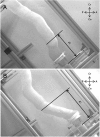A flow visualization model of duodenogastric reflux after esophagectomy with gastric interposition
- PMID: 24067071
- PMCID: PMC3849734
- DOI: 10.1186/1749-8090-8-192
A flow visualization model of duodenogastric reflux after esophagectomy with gastric interposition
Abstract
Background: Our goal was to verify surgical factors that affect duodenogastric reflux (DGR) after esophagectomy through the use of a flow visualization model that would mimic an intrathoracic gastric tube.
Methods: Transparent gastric tube models for different routes (retrosternal space [RS] and posterior mediastinum [PM]) were fabricated. Various distal pressures were applied to the experimental model filled with water, and the flow was recorded with a high-speed camera. The volume and maximum height of the refluxate through the pylori of two different sizes (7.5 mm, 15 mm) in two different postures (upright, semi-Fowler) was measured by analyzing the video clips.
Results: For the large pylorus setting, when the pressures of 20, 30, and 40 mmHg were applied in the upright position, the volumes of the refluxate in the RS/PM tubes were 87.7 ± 1.1/96.4 ± 1.7 mL, 150.8 ± 1.1/158.0 ± 3.2 mL, and 156.8 ± 3.3/198.0 ± 4.7 mL (p < 0.05), and the maximum heights were 101.6 ± 4.8/113.4 ± 2.9 mm, 151.4 ± 2.2/165.4 ± 1.5 mm, and 166.1 ± 1.7/193.7 ± 6.6 mm (p < 0.05). The data for the small pylorus setting or in the semi-Fowler position showed similar tendencies. For any given route, posture or pressure setting, DGR in the large pylorus model was definitively higher than that for small one.
Conclusions: This fluid mechanics study demonstrates posterior mediastinal gastric interposition or pyloric drainage procedure, or both, is associated with high reflux of duodenal contents.
Figures



Similar articles
-
Duodenogastric reflux after esophagectomy and gastric pull-up: the effect of the route of reconstruction.World J Surg. 2005 Feb;29(2):174-81. doi: 10.1007/s00268-004-7568-0. World J Surg. 2005. PMID: 15650801
-
Does troncular vagotomy modify the proliferative gastric lesions induced in rats by duodenogastric reflux?Acta Cir Bras. 2007 May-Jun;22(3):210-4. doi: 10.1590/s0102-86502007000300009. Acta Cir Bras. 2007. PMID: 17546294
-
Theoretical modeling of the resistance to gastric emptying and duodenogastric reflux due to pyloric motility alone, presuming antral and duodenal quiescence.J Theor Biol. 2021 Jan 7;508:110460. doi: 10.1016/j.jtbi.2020.110460. Epub 2020 Sep 4. J Theor Biol. 2021. PMID: 32891592
-
[Duodenogastric and gastroesophageal bile reflux].J Chir (Paris). 2006 Nov-Dec;143(6):355-65. doi: 10.1016/s0021-7697(06)73717-6. J Chir (Paris). 2006. PMID: 17285081 Review. French.
-
[Duodenogastric reflux in gastric and duodenal peptic ulcer].Klin Med (Mosk). 1984 Jun;62(6):31-7. Klin Med (Mosk). 1984. PMID: 6381877 Review. Russian. No abstract available.
Cited by
-
Assessment of the risk factors of duodenogastric reflux in relation to different dietary habits in a Chinese population of the Zhangjiakou area.Food Nutr Res. 2023 Oct 24;67. doi: 10.29219/fnr.v67.9385. eCollection 2023. Food Nutr Res. 2023. PMID: 37920676 Free PMC article.
-
Application of CellSearch technique in detection of peripheral blood circulating tumour cell count in patients with head and neck cancer and its association with prognosis.Oncol Lett. 2024 Dec 13;29(2):100. doi: 10.3892/ol.2024.14846. eCollection 2025 Feb. Oncol Lett. 2024. PMID: 39717066 Free PMC article.
References
-
- Yamashita Y, Hirai T, Saeki S, Yoshimoto A, Noma K, Toge T. Comparison of duodenogastric reflux (DGR) to esophageal substitute between retrosternal route and posterior mediastinal route. Nihon Kyobu Geka Gakkai Zasshi. 1994;42:1897–1903. - PubMed
MeSH terms
LinkOut - more resources
Full Text Sources
Other Literature Sources

